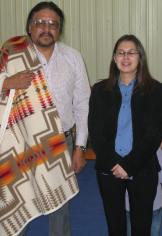Exploiting Native Americans? Hardly.
Having received email from readers who believe that Spirit Lake: The Game is exploitative or disrespectful of Native Americans, I asked the individual who designed the Level 5 problem shown in my blog post of November 18 to respond in a guest post.
 What I Hope to Accomplish with a Math Game for Native American Students
What I Hope to Accomplish with a Math Game for Native American Students
Dr. Erich Longie
Although this game is still in its early development stages the Native American students we are working with are really excited about it. What is exciting to us is that they think it’s entertainment when it’s actually a math game. However, what is most important to me is that the game’s theme is based on our Dakota culture. Students will be exposed to our culture from my, a Dakota wicasa’s (Indian man’s) point of view. Not the romanticized version, not the Indians are uncivilized savages version, but my version.
Take the problem AnnMaria talks about in this blog as an example. In the the final version the students will learn that horse stealing was an honorable sport among the Plains tribe. And only the bravest warriors crept into the villages to steal the most valuable horses, the war horses. They will learn that courage was the most desirable of all values. And, death in battle was preferred to dying of old age, That counting coup on the enemy without killing that enemy (horse stealing as an example) was the bravest act of all.
The game successfully combines culture, math skills and entertainment to make learning math interesting and fun.
The beginning of an explanation of number lines, given below, illustrates how culture is infused throughout our game.
There were no street lights or road signs when Tasina and Hoksinato lived on the prairie. Yet, they were able to walk to the river in darkest night to fetch water and back again without getting lost. How did they do it? When the sky was clear they used the stars to guide them and then they counted the number of steps it took to get to the river and back. Here is an example of the path they followed to the river and back. By learning how to count forward and back ward they were able to move around the village on the darkest nights and not get lost.
Students are constantly reinforced by positive information about their culture which in turn raises their self-esteem. A high self-esteem is critical for a student’s success.
(Note: You can read Dr. Longie’s blog posts at the lastrealindians.com website. Dr. Longie, who has earned three degrees from the University of North Dakota, has been an outspoken and active opponent of the Fighting Sioux logo. He is an enrolled member of the Spirit Lake Dakota Nation, co-founder and president of Spirit Lake Consulting, Inc. )

Thank you for your curriculum leadership, Erich and AnnMaria. While most Indian educators are choosing education materials off the shelf, you are developing relevant material for Indian students. I hope we will have the opportunity at Turtle Mountain to utilize them in the near future. Great job!
Thanks for the kind words. Coming from someone with your stature in Indian education, that means a lot.